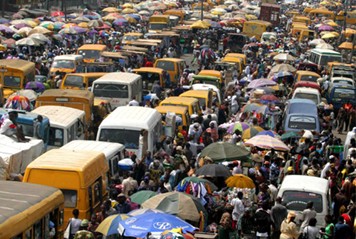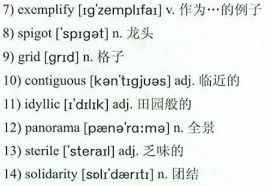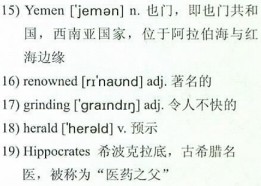文字难度:★★★

When observing the chaotic, 1)burgeoning growth of the modern city, the more 2)erudite of urban planners will reminisce wistfully on how different it is from its ancient Greek counterpart, the 3)polis, which Italian architectural historian Leonardo Benevolo once described as “dynamic but stable, in balance with nature, and growing manageably even after reaching large dimensions.”
The rapid and uncontrolled sprawl of today’s cities is breeding anxiety not only among urban planners and architects: experts in the field of public health are alarmed, that the apparent randomness of the urban dynamic is robbing the population of its basic health and well-being through unregulated environmental pollution, shrinking green areas, inadequate housing, overburdened public services, a 4)mushrooming of 5)makeshift settlements on the outskirts lacking in both infrastructure and services, mounting 6)anomie, and the sheer numbers of neighbors who do not know neighbors.
Beijing, a city of over 17 million inhabitants, according to a population report in 2009,7)exemplifies this social alienation. Until the early 1980s, the Chinese capital was constructed as a multitude of siheyuan, or one-story complexes built around a common courtyard that were inhabited by three or four families who shared a single kitchen and water 8)spigot. These courtyards were connected by narrow streets called hutong that formed a 9)grid from north to south and east to west.
This open structure greatly facilitated contact between neighbors, encouraged the sharing of resources, fostered relations between 10)contiguous families, and enabled the elderly to care for children and share with them their passion for songbirds. Because of these characteristics, these almost 11)idyllic structures were described as “collections of small rural villages.”
Until the mid-1980s, only a few skyscrapers disrupted the harmony of the landscape. Today, the 12)panorama has the look and feel of the ultimate modern city, where, with few exceptions, these “small rural villages” have been supplanted by 13)sterile, towering skyscrapers. This striking change is not limited to external structures; it has also dramatically altered the fabric of human relations.
看着现代城市混乱又迅速地发展,较有见识的城市规划者会带着羡慕的目光怀想起古希腊城邦是多么的不同。意大利建筑史学家列奥纳多·贝纳沃罗曾这样形容古希腊城邦——“生机勃勃而稳定向前,与大自然融合相生,规模再大发展也有条不紊。”
当今城市飞速扩张,该种局面处于失控状态,这不仅引发了城市规划者及建筑师的焦虑,公共卫生方面的专家也为之瞠目惶恐,因为城市在发展壮大过程中显示出的混乱无序——环境污染失控,绿化用地缩减,住房短缺,公共服务负担过重,因缺乏基础设施及公共服务而搭建的市郊临时安置区日益增多,世风日下,邻里之间老死不相往来——这些正在剥夺城市居民的基本健康及快乐。
据2009年人口统计,北京城拥有超过1700万的居民,而它正是处于这种社会疏离状况的例子之一。在20世纪80年代初之前,四合院遍布作为中国首都的北京,它们绕着共享的院子而建,楼高一层的房舍群落里面居住着三到四户人家,这些家庭共用一个厨房和水龙头。连接这些四合院的是一条条被称为胡同的狭窄街道,这些胡同形成巨网,贯彻城市的东西南北。
这种敞开式建筑格局极大地促进了邻里往来,鼓励资源共享,加深邻里感情,老人也能帮忙照顾小孩,并分享他们对鸣鸟的喜爱之情。基于这些特征,这类几乎如田园诗般美好的建筑被形容为“小村落集合体”。
到了20世纪80年代中期,只有少部分摩天楼打破北京城和谐的景致。如今,北京全貌无论是视觉上还是给人的感觉完全就是一个现代城市,除了少数几个四合院以外,其他的“小村落”全被高耸乏味的摩天楼取代。这种惊人的变化并不局限于外部建筑,也表现在人与人之间的关系上。
Physical isolation has destroyed the local sense of 14)solidarity, and contributed to the fragmentation of what were once cohesive family groups. As the distance between home and the workplace has also increased considerably, workers now find themselves devoting what was once valuable family time to exhausting commutes in overcrowded buses or subways.
And Beijing is not the only city losing the proper arrangement, its characteristic and history. Zabid is one of the oldest towns in 15)Yemen and was a vital center for learning during the 12th through 15th centuries, the Islamic Golden Age. It was home to the world-16)renowned University of Zabid, which was located here and is currently in a state of ruin. Unfortunately, Zabid has been reduced to the margins of Yemen’s intellectual and political worlds, and 17)grinding poverty has a grip on much of the population, who live surrounded by the crumbling remains of their ancestors’ glorious past. Expert surveys have found that the city’s heritage is in grave danger of being wiped away; over 40% of the city’s ancient houses have been replaced by poorly-constructed concrete housing, while the remaining houses and ruins of the University and palaces are in a state of advanced deterioration.
The chaotic growth of today’s cities can no longer be ignored. The great challenge is how to improve the quality of urban life by ensuring harmonious growth. Skyscrapers should not be the only view people can see in a city. Old-fashioned but unique architecture reflects history, character—even the culture of a city. Cities can—and should—learn from the experiences of other cities with similar characteristics. This effort requires not only the participation of urban planners but public health and environmental experts, politicians, and fundamentally, the communities themselves. Only when these actions are carried out will it be possible, perhaps, to reach that almost ideal situation 18)heralded by 19)Hippocrates some 2,600 years ago: a balance between the human organism and its environment.
空间距离破坏了当地居民的一种“团结”意识,也使曾经关系紧密的家庭联合体变得支离破碎。由于家和工作地点之间的距离大幅度地增加,上班族如今发现自己将原本宝贵的家庭时光用于累人的上下班往返路程,辛苦地去挤公交车和地铁。
而北京并非唯一一座丧失合理规划、个性及历史的城市。扎比德是也门历史最悠久的古镇之一,伊斯兰黄金年代(12世纪至15世纪)的文化中心,这里也是名誉天下的扎比德大学的旧址所在,而现在这里已是一片荒芜了。不幸的是,扎比德现在已难复“当年之勇”,不再是政治与学术中心了。生活在祖先留下的那些辉煌的古建筑的残垣断壁下,这里大部分人备受让人难受的贫穷的“魔爪”折磨。专家调查得知,这个城市的建筑遗产正面临着被毁灭殆尽这样的危险境地,城市40%的古建筑已被粗建滥造的水泥楼房所取代,而其余的古建筑和扎比德大学的旧校舍以及皇宫建筑均已残破失修。
如今我们必须正视城市混乱发展这一问题。其中莫大的挑战在于如何通过确保和谐发展来改善城市生活的质量。摩天楼不应该成为人们在城市里唯一能看见的景致。那些老式但独特的建筑反映了历史、城市个性,甚至一个城市的文化。城市能够——也应该——向其他与自己有着相同特征的城市学习其发展经验。这不仅需要城市规划者们付出努力,也需要公共卫生及环境专家、政客,及城市最基础的力量——社区本身付出努力。唯有大家着实行动起来,才可能达到希波克拉底于2600年前预示的那一种近乎完美的生存状况:人类与其环境平衡发展。




